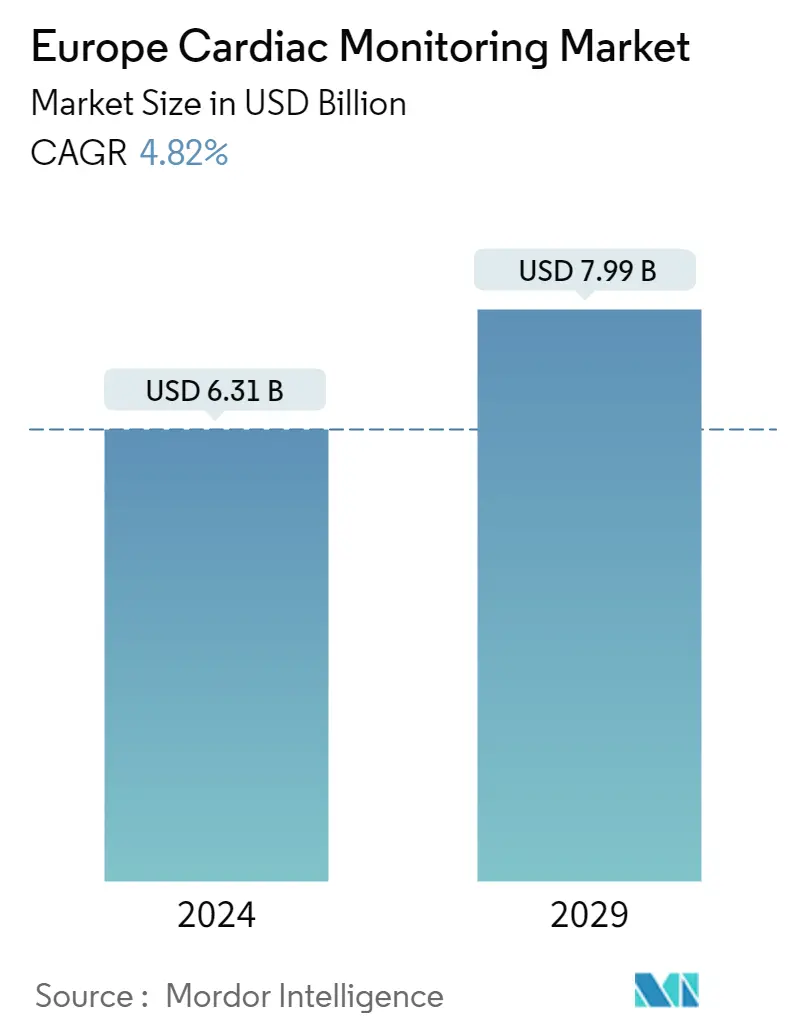Market Size of Europe Cardiac Monitoring Industry

| Study Period | 2019 - 2029 |
| Base Year For Estimation | 2023 |
| Forecast Data Period | 2024 - 2029 |
| Market Size (2024) | USD 6.31 Billion |
| Market Size (2029) | USD 7.99 Billion |
| CAGR (2024 - 2029) | 4.82 % |
Major Players
*Disclaimer: Major Players sorted in no particular order |
Europe Cardiac Monitoring Market Analysis
The Europe Cardiac Monitoring Market size is estimated at USD 6.31 billion in 2024, and is expected to reach USD 7.99 billion by 2029, growing at a CAGR of 4.82% during the forecast period (2024-2029).
The COVID-19 pandemic impacted the cardiac monitoring market significantly. There were fewer echocardiograms and other heart scans carried out during the pandemic, which means fewer people getting a diagnosis. The pandemic has also led to the delay of elective procedures due to COVID-19-related measures. For instance, British Heart Foundation (BHF) data updated in February 2021 found that there was a decrease in heart operations by 22% in England. Around 371,000 heart operations and procedures were performed in 2020, as compared to 2019 wherein more than 473,000 were carried out. Also, for non-urgent procedures, lifestyle changes, and medication were temporarily prescribed instead of cardiovascular procedures. Moreover, as per the study published in August 2021, by the National Library of Medicine, during the first wave of the COVID-19 pandemic, a marked decrease in hospital visits and admissions due to acute coronary syndromes, stroke, and heart failure decompensation was noted in Greece. Hence, this has resulted in a huge number of patients on the waiting list for cardiac surgery. For instance, as per December 2021 published article by the BHF, more than 275,000 people were waiting for heart tests and treatment, including heart surgery, at the end of September 2021 in England. This was 42,500 more people than in February 2020, before the pandemic. The number of people waiting over a year was 128 times higher than before the pandemic. Thus, to clear the backlogs of heart surgery in the region the market saw a surge. In addition, the market growth is stabilizing in the current scenario after COVID-19 as the disease screening services and surgeries have been resumed.
The key factors propelling the market growth are the growing incidences of cardiovascular diseases, advancements in technology, and the demand for home-based, point-of-care, and remote monitoring cardiac systems.
The increasing prevalence of cardiovascular disorders is one of the major factors driving the cardiac monitoring market. For instance, as per the BHF 2022 report, vascular dementia affected at least 150,000 people in the United Kingdom in 2022, and the number is predicted to rise to 350,000 by 2030. Hence, the high prevalence of cardiac diseases in European countries is anticipated to be the driving factor for the cardiac monitoring market.
Moreover, technological advancements in the field of cardiac monitoring are expected to boost the growth of the market over the forecast period. For instance, in September 2022, Huawei Consumer Business Group (CBG) announced that its latest smartwatch device, the HUAWEI WATCH GT 3 Pro and HUAWEI WATCH D, received CE certification for its HUAWEI ECG App. Similarly, in June 2021, MicroPort CRM announced the European launch of Alizea and Borea pacemakers after receiving the CE mark under the new Medical Device Regulation (MDR - 2017/745). The devices are equipped with Bluetooth1 technology for streamlined remote monitoring when paired with the SmartView Connect home monitor. Such advances are expected to boost the growth of the market over the forecast period.
Hence, with the increasing cases of cardiovascular diseases in the region, the market is anticipated to grow at a significant rate over the forecast period. However, the risk of infection due to implantable monitoring devices and unfavorable reimbursement policies are likely to restrain the market growth.
Europe Cardiac Monitoring Industry Segmentation
As per the scope of the report, cardiac monitoring devices are used to monitor and diagnose various abnormalities or disorders of the heart and the overall cardiovascular system. Continuous cardiac monitoring is an important tool in the clinical assessment of patients with a variety of conditions. It allows the detection of changes in heart rate and rhythm and is essential in the detection of life-threatening arrhythmias. This is achieved using a cardiac monitor connected to a cable lead and skin electrodes, which captures the electrical activity predominantly through a single view. There are various types of cardiac monitors available in the market.
The Europe Cardiac Monitoring Market is segmented by Device Type (ECG Monitor, Event Recorder, Implantable Loop Recorder, Pacemaker, Defibrillator, Cardiac Resynchronization Therapy (CRT) Devices, Smart Wearable Devices, and Other Device Types), End User (Hospitals and Clinics, Home Care Settings and Others) and Geography (Germany, United Kingdom, France, Italy, Spain, and Rest of Europe). The report offers the value (USD million) for the above segments.
| By Device Type | |
| ECG Monitor | |
| Event Recorder | |
| Implantable Loop Recorder | |
| Pacemaker | |
| Defibrillator | |
| Cardiac Resynchronization Therapy (CRT) Devices | |
| Smart Wearable Devices | |
| Other Device Types |
| By End User | |
| Hospitals and Clinics | |
| Home Care Settings | |
| Others |
| Geography | |
| Germany | |
| United Kingdom | |
| France | |
| Italy | |
| Spain | |
| Rest of Europe |
Europe Cardiac Monitoring Market Size Summary
The Europe Cardiac Monitoring Market is poised for significant growth, driven by the increasing prevalence of cardiovascular diseases and advancements in monitoring technology. The market, which experienced disruptions due to the COVID-19 pandemic, is now stabilizing as disease screening services and surgeries resume. The pandemic led to a backlog in cardiac procedures, which has subsequently fueled demand for monitoring devices. Key factors such as the rise in cardiovascular disorders, technological innovations, and the demand for home-based and remote monitoring systems are propelling market expansion. The introduction of advanced devices, like the HUAWEI ECG App and MicroPort CRM's pacemakers, highlights the ongoing technological advancements that are expected to further boost market growth.
The United Kingdom is anticipated to hold a significant share of the market, supported by its developed healthcare infrastructure and government initiatives aimed at addressing the cardiovascular disease burden. Programs like NHS England's "@Home initiative" are enhancing remote monitoring capabilities, thereby reducing hospital visits and readmissions. The market is characterized by fragmentation, with numerous players ranging from multinational corporations to smaller firms. Companies such as Abbott Laboratories, Medtronic, and Boston Scientific Corporation are key players, holding substantial market shares. The presence of these companies, along with government support and awareness programs, is expected to drive the market's growth over the forecast period.
Europe Cardiac Monitoring Market Size - Table of Contents
-
1. MARKET DYNAMICS
-
1.1 Market Overview
-
1.2 Market Drivers
-
1.2.1 Growing Incidences of Cardiovascular Diseases
-
1.2.2 Technological Advancements in the Cardiac Monitoring Products
-
1.2.3 Demand for Home-based, Point of Care, and Remote Monitoring Cardiac Systems
-
-
1.3 Market Restraints
-
1.3.1 Risk of Infection due to Implantable Monitoring Devices
-
1.3.2 Unfavorable Reimbursement Policies
-
-
1.4 Porter's Five Force Analysis
-
1.4.1 Threat of New Entrants
-
1.4.2 Bargaining Power of Buyers/Consumers
-
1.4.3 Bargaining Power of Suppliers
-
1.4.4 Threat of Substitute Products
-
1.4.5 Intensity of Competitive Rivalry
-
-
-
2. MARKET SEGMENTATION (Market Size by Value - USD million)
-
2.1 By Device Type
-
2.1.1 ECG Monitor
-
2.1.2 Event Recorder
-
2.1.3 Implantable Loop Recorder
-
2.1.4 Pacemaker
-
2.1.5 Defibrillator
-
2.1.6 Cardiac Resynchronization Therapy (CRT) Devices
-
2.1.7 Smart Wearable Devices
-
2.1.8 Other Device Types
-
-
2.2 By End User
-
2.2.1 Hospitals and Clinics
-
2.2.2 Home Care Settings
-
2.2.3 Others
-
-
2.3 Geography
-
2.3.1 Germany
-
2.3.2 United Kingdom
-
2.3.3 France
-
2.3.4 Italy
-
2.3.5 Spain
-
2.3.6 Rest of Europe
-
-
Europe Cardiac Monitoring Market Size FAQs
How big is the Europe Cardiac Monitoring Market?
The Europe Cardiac Monitoring Market size is expected to reach USD 6.31 billion in 2024 and grow at a CAGR of 4.82% to reach USD 7.99 billion by 2029.
What is the current Europe Cardiac Monitoring Market size?
In 2024, the Europe Cardiac Monitoring Market size is expected to reach USD 6.31 billion.

